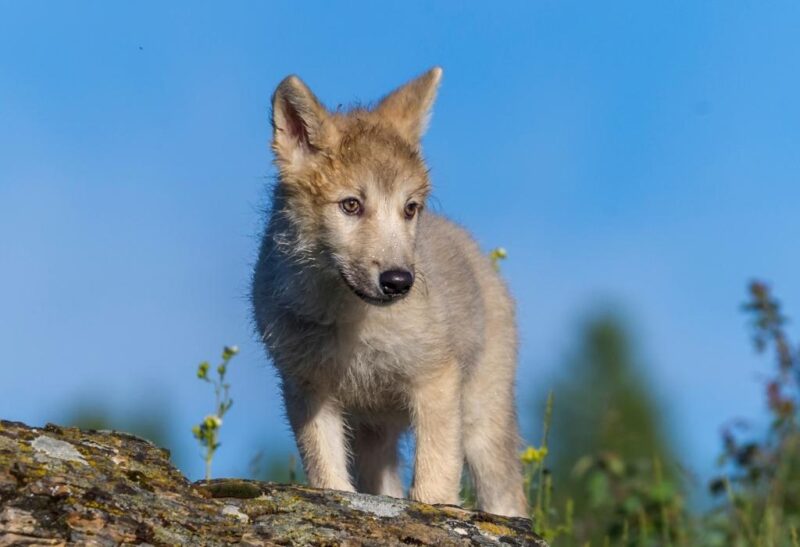Baby wolves are playful, just like dogs, their domesticated relatives. However, they get serious when learning how to hunt for prey, similar to young foxes when they forage for food.
Baby wolves are generally referred to as pups. They are born deaf and blind and rely on their mothers for milk until they’re old enough to chew and eat regurgitated meat. They’re considered juveniles at 3 months of age and fully mature at 3 years old.
This article cover wolf pups from their early lives up until they fully mature as adult wolves. There is also information regarding the breeding of wolf pairs, pregnancy and rearing of female wolves, and the social hierarchy in wolf packs.
Table of Contents
Wolf Pup Early Life
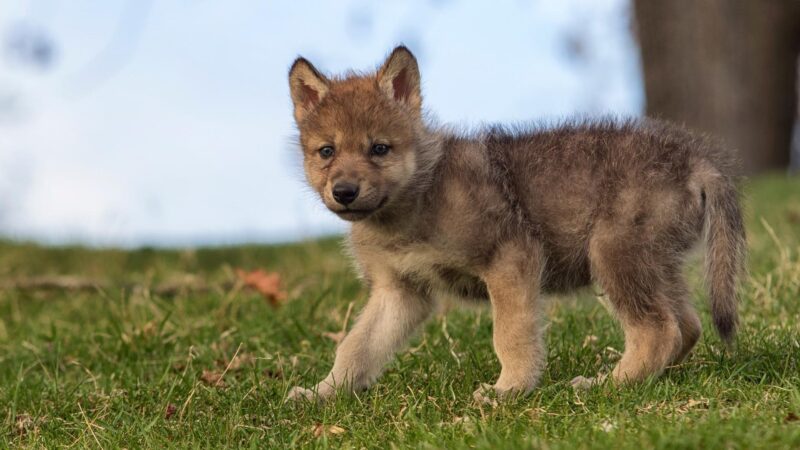
Wolf puppies go through 4 developmental stages in their early lives – neonatal, transitional, socialization, and juvenile periods.
Neonatal Period (Birth up to 12 Days)
- Pups are born deaf and blind and bear little to no resemblance to wolves with rounded heads, pug noses, dark bodies, curled ears, and weak feet.
- They aren’t able to walk, but they can crawl and paddle their way to their mothers to lick and suck milk or to huddle with their siblings for warmth. They can vocalize by whimpering when feeling cold, hungry, or in pain.
- Removing fecal and urine waste is done by the mother by licking their genital areas clean and eating droppings around the den.
Transitional Period (14 to 24 Days)
- Puppies’ eyes start to open at around 10 to 14 days, with the eye color being blue, but eyesight remains undeveloped until weeks later. They also start to grow their milk incisors which allows them to chew through regurgitated meat.
- Their limbs and muscles become more coordinated as they start learning how to stand and walk. They explore their dens warily, then come back to sleep with their siblings.
- At around 3 weeks, their ears begin to open as they start poking their heads out and looking at the outside world briefly before going back into their dens. After some time, they’ll keep hanging out, playing, and eliminating waste at the den entrance.
- Pups start to sort out the hierarchy in the litter, but this process may last until the next period.
Socialization Period (24 to 77 Days)
- Ears start to rise and hearing significantly improves. Once erect, the tips still tend to flop down. Heads and feet are large and disproportionate, with adult hair growing around the eyes and nose. Canines and premolar teeth also emerge.
- At 5 weeks, muscle and strength coordination is great enough to move away from predators or during bad weather back into the safety of their dens. They also follow adults for short periods of time when moving.
- From 5 to 10 weeks, growth and development are rapid with all their senses fully developed, and ingestion of solid food is made possible, but large cuts of meat are still difficult for them to eat. They will also depend on milk less.
- By 8 to 10 weeks, pups start to play with others and even play fight. They begin to develop bonds among their pack members and gain early hunting behaviors by chasing small mammals.
Juvenile Period (3 Months to 2 Years)
- Pups are considered juveniles at 3 months of age. They are brimming with energy and can explore their habitats by themselves. They start to accompany adults during hunting at 4 months of age but play a more observant role in learning hunting skills.
- They also have outgrown all their baby hair. Their eye color changes from blue to yellow-gold.
- At 9 months, they have the necessary skills and strength to kill their prey albeit small-sized. Some juveniles learn to diverge from their packs but may either stay up to 3 years or remain for life.
- At 2 years, they’re approaching the stage of sexual maturity, with some juveniles separating from their packs in the hopes of searching for potential mates. Others will remain in the pack and become full-fledged members of the adult hierarchy.
- Wolves are fully mature at 3 years of age, with males becoming dominant, hunting strategies are more complex, and become more attuned to living in the wild.
What Is the Mortality Rate of Wolf Pups?
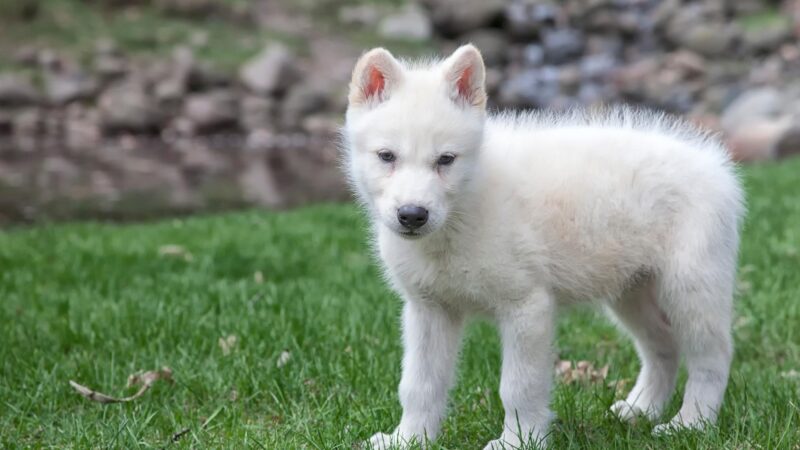
Wolf pup mortality rates vary per state per year. On average, about 40-60% of wolf pups die each year, according to the International Wolf Center.
Natural causes, such as starvation, wolf fights, diseases, and injuries inflicted by both prey and predators, are the main culprits of this high rate.
Human causes also contribute to the deaths of wolf pups due to activities such as hunting, poaching, and running over wolves with cars in areas with relatively high road densities.
How Many Months Is a Wolf Pregnant?
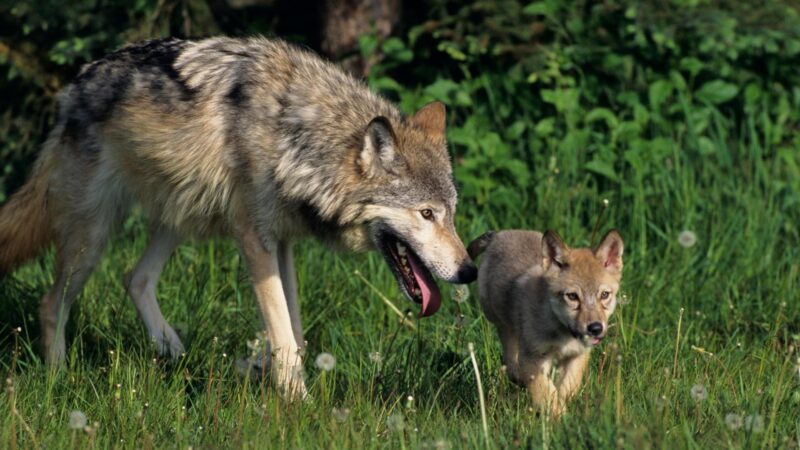
Wolves are pregnant typically for about two months, but it may slightly vary according to species. Refer to the guide below for the gestation period of different wolf species:
- Red Wolf – 60 to 62 days
- Gray Wolf – 60 to 63 days
- Mexican Gray Wolf – 63 to 65 days
- Arctic Wolf – 53 to 61 days
- Ethiopian Wolf – 60 to 62 days
How Many Babies Does a Wolf Have per Pregnancy?
The average number of offspring per litter per pregnancy is 3 to 6 pups, but it may also slightly vary according to species. Refer to the guide below for the range of pups born per pregnancy of different wolf species:
- Red Wolf – 1 to 12 pups
- Gray Wolf – 1 to 14 pups
- Mexican Gray Wolf – 4 to 7 pups
- Arctic Wolf – 1 to 12 pups
- Ethiopian Wolf – 2 to 6 pups
What Month Do Wolves Breed?
Wolves breed once a year, typically during the months between January to March. This applies to red wolves, gray wolves, and Mexican gray wolves.
For Ethiopian wolves, the season starts as early as October up to January, while Arctic wolves breed around March to April.
The courtship between a wolf pair typically occurs around November to December. When wolves mate, they may either mate for life with their partner, or one or both of them leaves the pack, find a new mate, and start a new pack.
Where Do Female Wolves Give Birth?
Females dig up wolf dens before or after breeding, usually near water sources, since the females will constantly need to replenish themselves once the pups are born.
Dens are usually downward sloping at the entrance and then upward sloping areas as wolves go inside to prevent the risk of flooding. They’re also located near sandy buffs, trees, boulders, rocky crevices, caves, and outcrops, depending on the location of the wolves.
Wolves make sure they build their dens within pack territory to avoid being ambushed by wolves of other packs.
How Do Wolves Carry Their Babies?
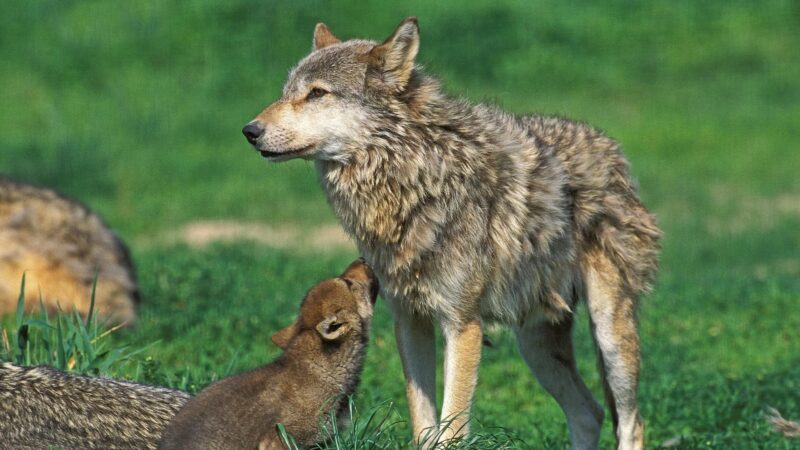
Wolves carry their young by biting on a thin layer of their skin and fur and then picking them up, similar to how dogs carry their babies. Puppies are only carried for the first two months after birth.
How Many Members Are Usually in a Wolf Pack?

Most packs will have 5 to 9 members, but some are as extensive as 20 members. Wolves develop strong social bonds among members of the pack.
The sizes of their territories depend on the ecosystem they live in, but the average range is 80 to 150 square miles. When living in the forests, their territory can be as small as 7.5 square miles, while in arctic regions, they can be as large as 1,000 square miles.
What Are the Positions in a Wolf Pack?
A wolf pack has 4 ranks according to hierarchy level and role in the pack which is: alpha, beta, delta, and omega. Below is a summary of a wolf hierarchy based on a study from the University of Bridgeport and a 2017 study:
| Hierarchy Level | Rank Title | Role Played in the Pack |
| 1 | Alpha | A male and female leader who guides and protects the pack as well as makes decisions. |
| 2 | Beta | Second in command, serves as an advisor to the alpha and as a rules enforcer to the pack. They’re often larger and stronger than the alphas. |
| 3 | Delta | Watches and guards over territory boundaries, takes care of wounded and ill wolves, chasing and tiring out prey, and warns other pack members for danger. They’re smaller in size and faster than most members. |
| 4 | Omega | Peacemakers in the pack during conflicts. They obey the dominant wolves and eat after they’ve finished eating. |
How Long Does a Baby Wolf Stay With Its Mother?
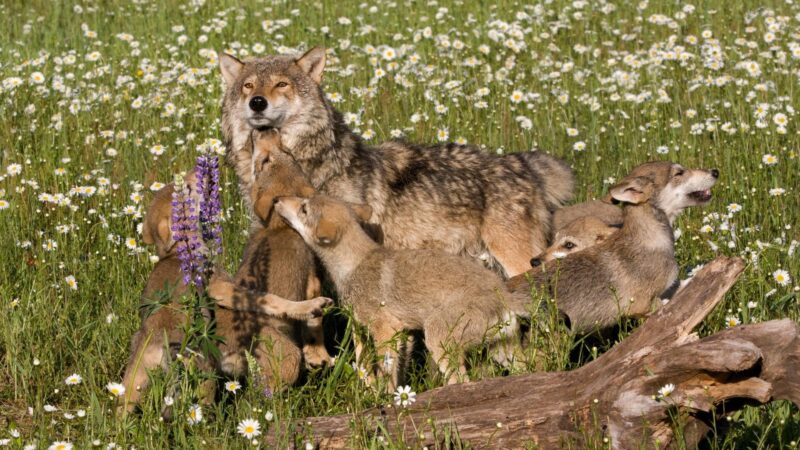
Around 9 months when they’re old enough to hunt and kill by themselves without the aid of their mothers or other members of the pack. At 8 to 10 weeks, they’ll stop depending on milk from their mothers, however, they’re still often accompanied by them.
Do Wolves Eat Their Babies?
Wolves don’t eat their babies. However, in situations when they’re under extreme duress and hunger, they may result in filial cannibalism, but this is rare among wolves.
What Do Baby Wolves Eat?
Baby wolves eat milk from their mothers and regurgitated meat when their teeth are developed enough to chew.
How Does a Wolf Give Birth?
Wolves give live births similar to dogs in well-excavated dens or logs, caves, abandoned lodges, and under trees if they haven’t constructed any dens yet.
Can You Own a Baby Wolf?
Owning a baby wolf depends on the state you live in. Owning, buying and selling, importing, and propagating wolves and any of their hybrids are illegal in states such as Massachusetts. You would have to check your state’s federal laws first before considering owning a baby wolf.
Keep in mind that wolf pups, at around 2 years old, may choose to separate from their pack or remain in it. They are fully mature at 3 years old and become adult members of their packs. Typical wolf pairs usually breed around January to March, with the female pregnancy lasting for 2 months before giving birth to 3 to 6 puppies in dens.
List of Sources
Montanaro, A. S. Wolves of Today. University of Bridgeport.
Abdulgader, M., Lakshminarayanan, S., Kaur, D. (2017). Efficient energy management for smart homes with grey wolf optimizer. International Conference on Electro Information Technology (EIT).
Wildlife as pets. Commonwealth of Massachusetts.
Bunker, A. (2007). Canis simensis. Animal Diversity Web.
Kenyon, S. (2014). How wolves die. University of Wisconsin-Madison.
